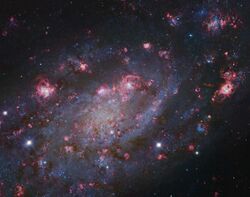Astronomy:NGC 2404
From HandWiki
Short description: Large, emission nebula in the constellation Camelopardalis
| Emission nebula | |
|---|---|
| H II region | |
 NGC 2404 is the giant H II region to the left | |
| Observation data: J2000 epoch | |
| Right ascension | 07h 36m 51.4s[1] |
| Declination | +65° 36′ 09″[1] |
| Distance | 9,650,000 ly |
| Apparent magnitude (V) | +16.9 |
| Apparent dimensions (V) | 20 arcsecs[2] |
| Constellation | Camelopardalis |
| Physical characteristics | |
| Radius | 470 (estimated)[3] ly |
| Absolute magnitude (V) | -14.5 |
| Notable features | Massive H II region, the largest one in NGC 2403. |
NGC 2404 is a massive H II region inside NGC 2403, a spiral galaxy in Camelopardalis. It was discovered on February 2, 1886 by Gulliaume Bigourdan. NGC 2404 is approximately 940 ly in diameter, making it one of the largest H II regions so far known. It is the largest H II region in NGC 2403, and lies at the outskirts of the galaxy, making for a striking similarity with NGC 604 in M33, both in size and location in the host galaxy. This H II region contains 30-40 Wolf-Rayet stars,[4] and unlike the Tarantula Nebula, but similar to NGC 604, NGC 2404's open cluster is probably much less compact, so it probably looks like a large stellar association. This H II region is probably only a few million years old.
References
- ↑ 1.0 1.1 "NASA/IPAC Extragalactic Database". Results for NGC 2403. http://nedwww.ipac.caltech.edu/.
- ↑ http://library.navoiy-uni.uz/files/O'Meara%20C.%20O.%20-%20The%20Caldwell%20Objects%20(1st%20edition)(2002)(484s).pdf [bare URL PDF]
- ↑ distance × sin( diameter_angle / 2 ) = 470 ly. radius
- ↑ Finlay, W. H. (April 18, 2006). Concise Catalog of Deep-sky Objects: Astrophysical Information for 500 Galaxies, Clusters and Nebulae. Springer Science & Business Media. ISBN 9781852338510. https://books.google.com/books?id=XHIQBwAAQBAJ&q=ngc+2404&pg=PA31-IA41.
 |

